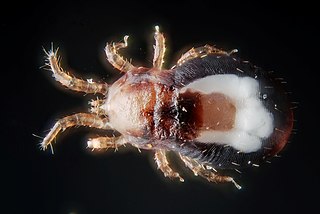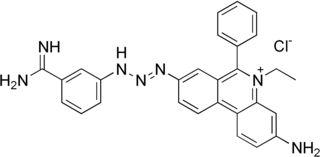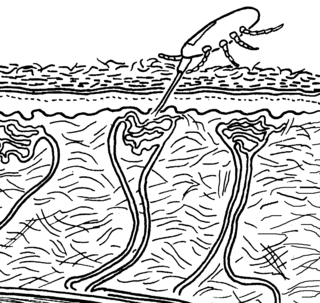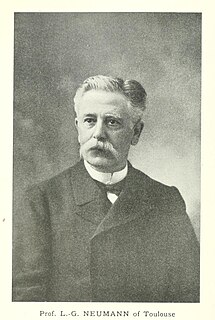Related Research Articles

Parasitology is the study of parasites, their hosts, and the relationship between them. As a biological discipline, the scope of parasitology is not determined by the organism or environment in question but by their way of life. This means it forms a synthesis of other disciplines, and draws on techniques from fields such as cell biology, bioinformatics, biochemistry, molecular biology, immunology, genetics, evolution and ecology.

Abamectin is a widely used insecticide and anthelmintic. Abamectin, is a member of the Avermectin family and is a natural fermentation product of soil dwelling actinomycete Streptomyces avermitilis. Abamectin, differs from Ivermectin, the popular member of the Avermectin family, by double bond on C-22-25. Fermentation of Streptomyces avermitilis yields 8 closely related Avermectin homologues out of which B1 forms the bulk of the fermentation. The non proprietary name, abamectin, is a combination of Bla and B1b. Out of all the Avermectins, abamectin is the only one that is used both in agriculture and pharmaceuticals.
Egg hatch assay (EHA), also called an egg hatch test (EHT), is a method used to determine a given parasite's resistance to extant drug therapy.

Dirofilariasis is an infection by parasites of the genus Dirofilaria. It is transmitted through a mosquito bite; its main hosts include dogs and wild canids. These can give rise to granulomas in the pulmonary artery. Some common symptoms include cough, fever and pleural effusion. It may also appear on X-rays of the chest.

The cat flea is an extremely common parasitic insect whose principal host is the domestic cat, although a high proportion of the fleas found on dogs also belong to this species. This is despite the widespread existence of a separate and well-established "dog" flea, Ctenocephalides canis. Cat fleas originated in Africa but can now be found globally. As humans began domesticating cats, the prevalence of the cat flea increased and spread throughout the world.

Dermanyssus gallinae is a haematophagous ectoparasite of poultry. It has been implicated as a vector of several major pathogenic diseases. Despite its common names, it has a wide range of hosts including several species of wild birds and mammals, including humans. In both size and appearance, it resembles the northern fowl mite, Ornithonyssus sylviarum.

Trypanosoma congolense is a species of trypanosomes and is the major pathogen responsible for the disease nagana in cattle and other animals including sheep, pigs, goats, horses and camels, dogs, as well as laboratory mice. It is the most common cause of nagana in east Africa, but is also a major cause of nagana in west Africa. This parasite is spread by tsetse flies. In its mammalian host, Trypanosoma congolense only lives in blood vessels, and causes in particular anaemia.

Isometamidium chloride is a triazene trypanocidal agent used in veterinary medicine.

Ancylostoma braziliense is a species of hookworm belonging to the genus Ancylostoma. It is an intestinal parasite of domestic cats and dogs. Severe infection is often fatal to these pets, especially in puppies and kittens. The infection is particularly endemic in the southern United States. It is most often confused with the zoonotic hookworm species Ancylostoma ceylanicum because of their uncanny resemblance.

Gamasoidosis, or dermanyssosis, is a frequently unrecognized ectoparasitosis and source of growing concern in human medicine, occurring after contact with avian mites which infest canaries, sparrows, starlings, pigeons and poultry and caused by two genera of mites, Ornithonyssus and Dermanyssus. Avian mite species implicated include the red mite, tropical fowl mite and northern fowl mite . Mite dermatitis is also associated with rodents infested with the tropical rat mite, spiny rat mite and house-mouse mite, where the condition is known as rodent mite dermatitis. Urban gamasoidosis is associated with window-sills, ventilation and air-conditioning intakes, roofs and eaves, which serve as shelters for nesting birds. Humans bitten by these mites experience a non-specific dermatitis with intense itching.

Teladorsagia circumcincta is a nematode that is one of the most important parasites of sheep and goats. It was previously known as Ostertagia circumcincta and is colloquially known as the brown stomach worm. It is common in cool, temperate areas, such as south-eastern and south-western Australia and the United Kingdom. There is considerable variation among lambs and kids in susceptibility to infection. Much of the variation is genetic and influences the immune response. The parasite induces a type I hypersensitivity response which is responsible for the relative protein deficiency which is characteristic of severely infected animals. There are mechanistic mathematical models which can predict the course of infection. There are a variety of ways to control the infection and a combination of control measures is likely to provide the most effective and sustainable control.
Raffaele Molin was an Italian scientist with successful career as physician, zoologist, geologist. He is most revered for his works in ichthyology and parasitology. He is immortalised as the authority of a number of parasitic worms.

Cooperia oncophora is one of the most common intestinal parasitic nematodes in cattle in temperate regions. Infections with C. oncophora may result in mild clinical symptoms, but can lead to weight loss and damage of the small intestine, especially when co-infections with other nematodes such as O. ostertagi occur. Infections are usually treated with broad-spectrum anthelmintics such as benzimidazole, but resistance to these drugs has developed in the last decades and is now very common. C. oncophora has a direct life cycle. Infective larvae are ingested by the host. The larvae grow to adults, which reproduce in the small intestines. Eggs are shed onto the pasture with the faeces, which leads to new infections. Co-infections with other gastro-intestinal nematodes such as O. ostertagi and H. contortus are common.

Otodectes is a genus of parasitic mite in the superfamily Psoroptidae. There is a single species of mite in this genus, Otodectes cynotis. This mite is within the class Arachnida and subclass Acari for mites and ticks. Otodectes are external parasites (ectoparasites) of dogs, cats and ferrets, but can be found on many other mammals. Otodectes is found worldwide.
Ostertagia ostertagi, commonly known as the medium stomach worm or brown stomach worm, is a parasitic nematode of cattle. O. ostertagi can also be found to a lesser extent in sheep, goats, wild ruminants, and horses. It causes ostertagiosis, which is potentially fatal in cattle. It is found worldwide and is economically important to cattle industries, particularly those found in temperate climates.
The fecal egg count reduction test was suggested in the World Association for the Advancement of Veterinary Parasitology guideline for estimating the reduction in fecal egg counts and its corresponding confidence interval. The results of this test can be used to determine the anthelmintic resistance status of the animals.

Cooperia is a genus of nematode from the Cooperiidae family that is one of the most common intestinal parasitic nematodes in cattle in temperate regions. Infections with Cooperia may result in mild clinical symptoms, but can lead to weight loss and damage of the small intestine, especially when co-infections with other nematodes such as Ostertagia ostertagi occur. Infections are usually treated with broad-spectrum anthelmintics such as benzimidazole, but resistance to these drugs has developed in the last decades and is now very common. Cooperia has a direct life cycle. Infective larvae are ingested by the host. The larvae grow to adults, which reproduce in the small intestines. Eggs are shed onto the pasture with the faeces, which leads to new infections. Co-infections with other gastro-intestinal nematodes such as O. ostertagi and Haemonchus contortus are common.

Cooperiidae is a family of nematodes that are one of the most common intestinal parasitic nematodes in cattle in temperate regions.

Louis Georges Neumann was a French veterinary parasitologist who specialized in ticks. He was a professor at the Veterinary School in Toulouse.
Morris Soller (1931–) is a research professor in the Department of Genetics of the Hebrew University of Jerusalem. He is especially interested in livestock- and crop- genetics including trypanotolerance in cattle.
References
- ↑ "About the AAVP (new 2)". American Association of Veterinary Parasitologists. 2010-01-01. Retrieved 2022-02-25.
- ↑ Bliss, Donald H.; Moore, Robert D.; Kvasnicka, William G. (2008-09-25). "Parasite Resistance in US Cattle". American Association of Bovine Practitioners Proceedings of the Annual Conference. American Association of Bovine Practitioners: 109–114. doi:10.21423/aabppro20084377. ISSN 1079-9737. S2CID 32746233.
- ↑ "Continuing Education". Government of Tennessee . 2017-10-09. Retrieved 2022-02-25.
- ↑ Ballweber, L.R.; Beugnet, F.; Marchiondo, A.A.; Payne, P.A. (2014). "American Association of Veterinary Parasitologists' review of veterinary fecal flotation methods and factors influencing their accuracy and use—Is there really one best technique?". Veterinary Parasitology . American Association of Veterinary Parasitologists (AAVP) + European Veterinary Parasitology College (EVPC) + World Association for the Advancement of Veterinary Parasitology (WAAVP) (Elsevier). 204 (1–2): 73–80. doi:10.1016/j.vetpar.2014.05.009. ISSN 0304-4017.
- ↑ Stromberg, Bert E. (2002). "Teaching veterinary parasitology: the North American perspective". Veterinary Parasitology . American Association of Veterinary Parasitologists (AAVP) + European Veterinary Parasitology College (EVPC) + World Association for the Advancement of Veterinary Parasitology (WAAVP) (Elsevier). 108 (4): 327–331. doi:10.1016/s0304-4017(02)00232-7. ISSN 0304-4017.
- ↑ "Veterinary Parasitology - Journal". ScienceDirect.com by Elsevier. 2022-02-24. Retrieved 2022-02-25.